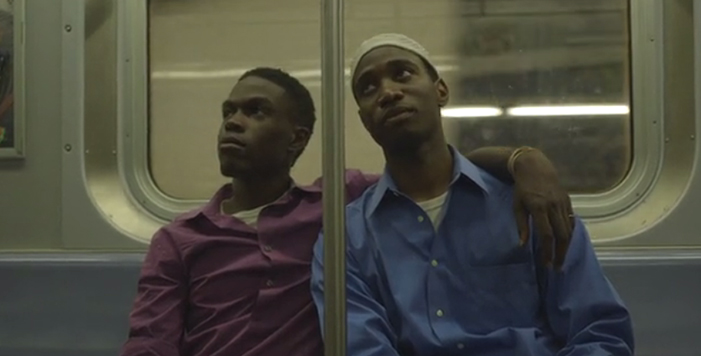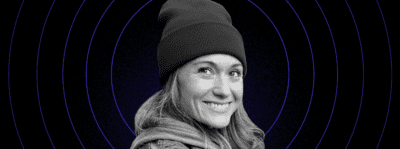“It’s a privilege to be carefree”: Talking to Jay Dockendorf about Naz & Maalik
In description, Jay Dockendorf’s Naz & Maalik sounds like it has a pretty aggressive hook: two black Muslim teens, very much in the closet to their religious families, come under FBI attention for their furtive behavior over the course of an afternoon in Brooklyn. In fact, much of the film consists simply of the two young men (Curtiss Cook Jr. as the wide-smiling, outgoing born salesman Maalik; Kerwin Johnson Jr. as the moodier, conscientious Naz) hanging out, talking about politics and morality, reselling perfume and scratch tickets on the street, and flirting or kissing, when they think it’s safe. The narrative serves the competing interests of naturalism and melodrama, which feels appropriate to the slightly unreal, troubled everyday of its characters.
Local audiences will thrill to the locations, primarily around Bed-Stuy and Fort Greene—where Dockendorf has lived for two and a half years—and the many scenes on and in the subway, which capture beautifully the loose-limbed sense of killing time on the platform, and the sudden transient flutter of aimless mobility and temporary society when the train comes. The film opens this Friday at Cinema Village, and is available on-demand from Tuesday the 26th. Jay Dockendorf answered a few questions of mine over email.
You’ve said that this film was inspired by your conversations with a closeted Muslim man in Bed-Stuy—how did those that link up with the surveillance angle, what in your mind connected surveillance with the struggles of closeted kids in religious communities?
I think both closeted kids and religious communities under surveillance are subject to pressures that restricts individual freedom. When I imagined the characters and the film, I saw someone looking over their shoulder, feeling like their troubles had just doubled when they learned the cops were watching, knowing all the while that their parents were already watching them, expecting them to be something they’re not. The pressures felt parallel and overlapping. Personally I’ve had a bone to pick with paternalism in all its forms. That may be one of the biggest things I personally share with the story that drew me to the film.
You’ve also said that you were inspired to incorporate the FBI element when you read about the NYPD’s surveillance of Muslim communities, and that you interviewed a number of people who “may or may not have been under surveillance” by the NYPD. Can you tell me a little bit more about the research? (Were the FBI surveillance and interview practices we see in the film also researched, or more imagined for dramatic expediency?)
The FBI tactics and language in the film were researched largely through news accounts of the ways surveillance was carried out and partially through communication with Muslim young men and women who believed they were under surveillance. I think, for a long time, part of the idea was to simply create a sense that the Muslim community was being watched. The surveillance wasn’t completely clandestine. FBI agents would basically go door to door to “get to know the neighborhood” in a strange and menacing reminder of their presence.
The NYPD was also surveilling student groups at Yale when I was an undergrad there, and some of my friends were a part of those groups. There’s no proof there was an undercover presence there but there is an internal report that an undercover cop infiltrated a Muslim student organization at City College of New York and went on a white water rafting trip with the members of the group. I find that so disturbing.
What were the challenges of writing teenaged characters (and black, closeted, Muslim teens at that)?
I wanted them to be smart, smarter than teen characters usually are in films, but not annoying or mouthpieces for me, or too smart that they didn’t make mistakes that would allow for dramatic conflicts. I’m a private tutor on the side, so I’ve worked with a lot of teens this age, and I was excited to depict how eager they can be to wax philosophical, to grind their intellectual ax against any topic. And in high school my favorite thing was to get out of the house and sneak around with my friends, so that was a feeling I wanted to bottle somehow.
Tell me about casting—what sold you on Curtiss Cook Jr. and Kerwin Johnson Jr. as Naz and Maalik?
I saw about 100 young men for the roles and the decision came down to personality: Curtiss has a natural charisma; Kerwin exudes kindness. Both of them are so handsome. I could immediately imagine them in love. They gave great auditions and callbacks, and once I cast them I was relieved that they were already so connected to themes of spirituality and family. They were both very funny and clever collaborators who gave the film a huge amount of its life.
Local viewers, who recognize all the Bed-Stuy and Fort Greene locations, will appreciate that gentrification is a concern in the film—the characters encounter people from different socioeconomic backgrounds, and talk about condos. Does the concern with gentrification dovetail with the sense of surveillance and guilt, for you? That everything about these kids’ lives is somehow contested, politicized?
The anti-gentrification themes of the film may be a challenge for some audiences. Many other issues at play may not directly relate to their lives, but increasingly those who live in NYC or other large cities will have to make a decision about gentrification. It dovetails with the other conflicts of the movie in that I was excited to let the film survey enough topics that everyone is a bit uncomfortable by the end. And, although it’s hard to reduce this down to a short answer, to some degree, every major aspect of these characters’ lives is politicized. It’s a privilege to be carefree, and while the characters do get to experience that for a bit through being alone together, all too quickly they’re yanked out of their happiness and back into the various other obstacles of their lives.
You might also like 





















